What Can Open Openoffice.org Xml 1.0 Drawing (.sxd)?
OpenOffice or LibreOffice ?
OpenOffice and LibreOffice are the master open up-source office suites, the opensource equivalent to Microsoft Office, to create text document, spreadsheets, presentations and drawings.
LibreOffice was a fork of OpenOffice.org (when OpenOffice went under Oracle's umbrella) and is built on the original OpenOffice.org code base.
Both are equivalent, but the usual propose is to employ LibreOffice (see the differences) since information technology is the projection of the volunteers from the open-source community and has been developping more quickly.
I'll speak most LibreOffice at present, simply the aforementioned is true for OpenOffice.
Download Libreoffice
and in the menu bar LibreOffice > Preferences, enable macros
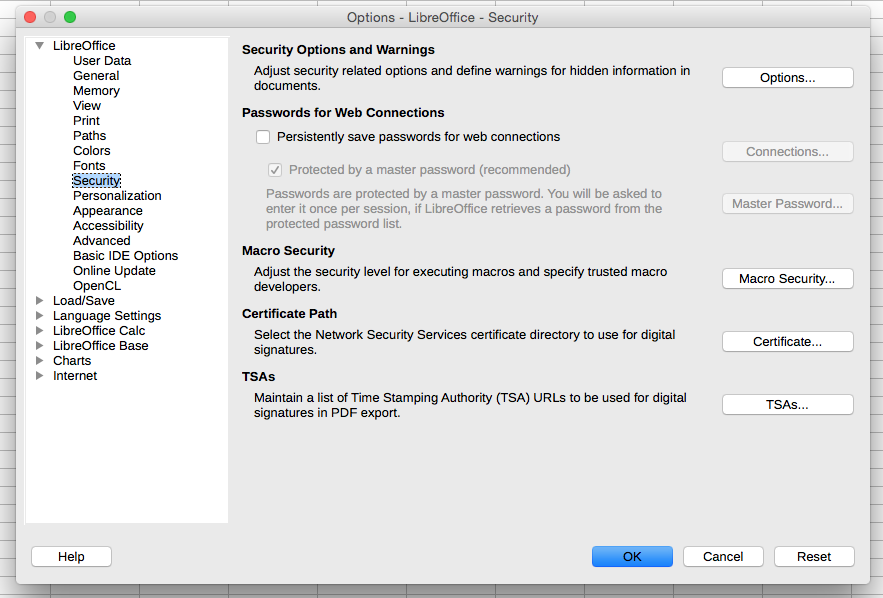
I would recommend you to ready Macro security to Medium which volition not block nor permit macros merely warning you to choose if you lot trust the editor of the document :
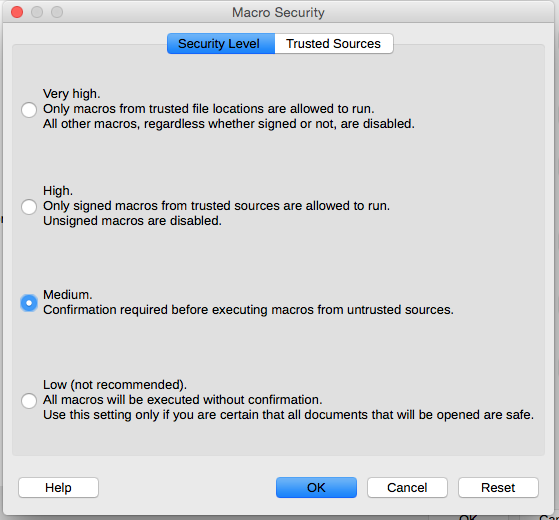
Which language choice for writing your LibreOffice macros ?
Macros are scripting for the office suite.
Many languages are accepted by the LibreOffice API, thanks to the Universal Network Objects (UNO). Amid them are : Visual Basic, Coffee, C/C++, Javascript, Python.
The API is interface-oriented, meaning your code communicate with the controller of the interface and the certificate has to be open up. Many other Python libraries are not interface-oriented, creating directly the file in the Open up Document format and saving it to disk with the correct extension
- .odt for text files
- .ods for spreadsheets
- .odp for presentations
- .odg for drawings
For the choice of the linguistic communication, I would commencement insist on the multi-platform requirement, which means it'south better if the macro / script can be executed on different platforms such as Windows, Mac Bone or Linux, because LibreOffice is also multi-platform and documents will be shared between users from which nosotros cannot expect a particular platform. Visual Basic is non multi-platform and would require significant changes from one plateform to another (Visual Bones, Real Basic, AppleScript…).
Java and C/C++ require compilation, are much more circuitous and verbose.
For a scripting need, I would advise Javascript or Python. Both are very present in script development earth wide and are standards de facto. Many tools have been built for task automation on Javascript, such every bit Cordova (the multi-platform mobile app framework) or Grunt. Many other tools are using Python also, such as AWS CLI for example.
I would advise to write most of your code logic exterior the interface-orientated architecture, post-obit a standard lawmaking architecture, with your common NodeJS dependencies or Python libraries.
Only, Javascript could be not precise enough to work nicely in your spreadsheets (fifty-fifty though there exists very nice libraries for numeric computation) and could be disconcerting for your Office users due to rounding errors ( 0.1 + 0.2 does not equals 0.3 in Javascript).
On the reverse, Python has been used extensively for numeric computation, with famous libraries such as Numpy, Numexpr … which make it perfect for spreadsheet macros.
Python has besides numerous available libraries for other purposes, due to its success and support from big digital companies, such every bit Excel reading or writing libraries which brand it the perfect option for macro development.
Even though Python 2.7 still remains very used, and Python 3 introduced differences, the latest version of LibreOffice comes with Python 3.3, and then the use of Python three.3 is advised for immovability.
/Applications/LibreOffice.app/Contents/MacOS/python --version #Python 3.3.five First play with the Python shell to get familiar
Earlier creating your own macro, let's play with the Python shell and interact with a document, let's say a spreadsheet.
Kickoff launch LibreOffice Calc (Calc for spreadsheet open documents) with an open socket to communicate with from the crush on your Mac Bone :
/Applications/LibreOffice.app/Contents/MacOS/soffice --calc \ --take = "socket,host=localhost,port=2002;urp;StarOffice.ServiceManager" (for the Windows command : "C:\\Program Files (x86)\LibreOffice v\program\soffice.exe" --calc --take="socket,host=localhost,port=2002;urp;" but if any problem, have a look the proposed workarounds).
and launch the Python shell
/Applications/LibreOffice.app/Contents/MacOS/python (for the Windows control : "C:\\Program Files (x86)\LibreOffice 5\program\python.exe").
Python-Uno, the library to communicate via Uno, is already in the LibreOffice Python's path.
To initialize your context, type the post-obit lines in your python crush :
import socket # only needed on win32-OOo3.0.0 import uno # become the uno component context from the PyUNO runtime localContext = uno . getComponentContext () # create the UnoUrlResolver resolver = localContext . ServiceManager . createInstanceWithContext ( "com.sunday.star.bridge.UnoUrlResolver" , localContext ) # connect to the running office ctx = resolver . resolve ( "uno:socket,host=localhost,port=2002;urp;StarOffice.ComponentContext" ) smgr = ctx . ServiceManager # go the central desktop object desktop = smgr . createInstanceWithContext ( "com.sun.star.frame.Desktop" , ctx ) # access the current writer certificate model = desktop . getCurrentComponent () These lines are common for every documents (Text, Spreadsheet, Presentation, Cartoon).
Now you can interact with the document.
Since we launched LibreOffice with --calc option, let'south attempt the spreadsheet interactions :
# access the active sail active_sheet = model . CurrentController . ActiveSheet # access cell C4 cell1 = active_sheet . getCellRangeByName ( "C4" ) # prepare text inside cell1 . String = "Hello world" # other example with a value cell2 = active_sheet . getCellRangeByName ( "E6" ) cell2 . Value = cell2 . Value + 1 If you open a text document and access it with a new document author, you lot tin can attempt the following interactions :
# access the certificate's text property text = model . Text # create a cursor cursor = text . createTextCursor () # insert the text into the certificate text . insertString ( cursor , "How-do-you-do World" , 0 ) Here is a schema for what nosotros've just done : the shell communicates with the LibreOffice runtime to command actions inside the electric current document.
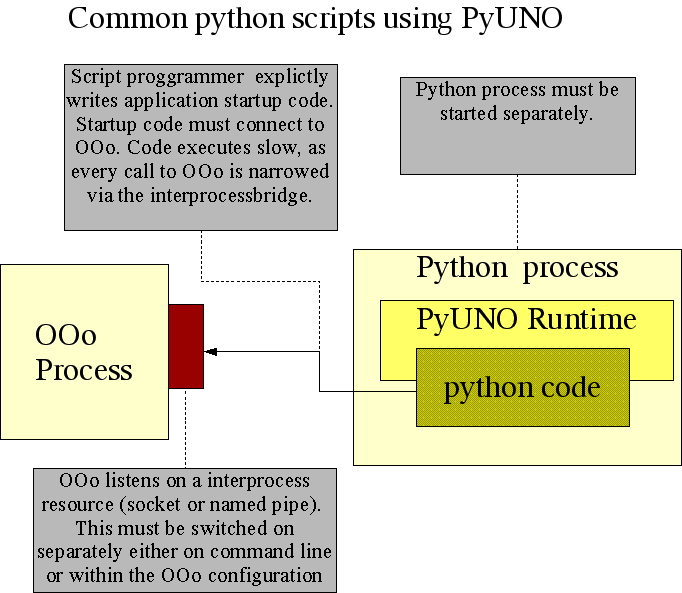
Create your get-go macro
It is the other manner, the macro is called from inside the Libreoffice program :
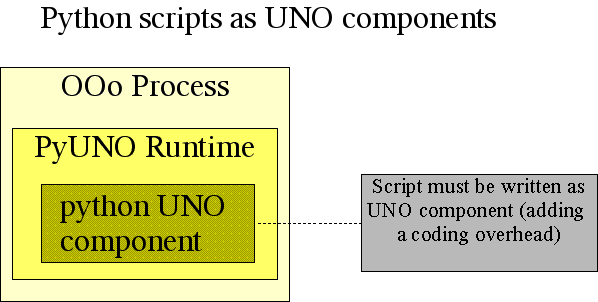
OpenOffice.org does not offering a style to edit Python scripts. You lot have to use your ain text editor (such as Sublim, Atom…) and your own commands.
There are 3 places where you can put your lawmaking. The first way is to add it equally a library for LibreOffice in ane of the directories in the PYTHONPATH
import sys for i in sys . path : print ( i ) which gives
/Applications/LibreOffice.app/Contents/Resources /Applications/LibreOffice.app/Contents/Frameworks /Applications/LibreOffice.app/Contents/Frameworks/LibreOfficePython.framework/Versions/3.3/lib/python3.3 /Applications/LibreOffice.app/Contents/Frameworks/LibreOfficePython.framework/Versions/iii.3/lib/python3.3/lib-dynload /Applications/LibreOffice.app/Contents/Frameworks/LibreOfficePython.framework/Versions/3.3/lib/python3.3/lib-tk /Applications/LibreOffice.app/Contents/Frameworks/LibreOfficePython.framework/Versions/iii.three/lib/python3.3/site-packages /Applications/LibreOffice.app/Contents/Frameworks/LibreOfficePython.framework/lib/python33.cipher /Applications/LibreOffice.app/Contents/Frameworks/LibreOfficePython.framework/lib/python3.three /Applications/LibreOffice.app/Contents/Frameworks/LibreOfficePython.framework/lib/python3.3/plat-darwin /Applications/LibreOffice.app/Contents/Frameworks/LibreOfficePython.framework/lib/python3.three/lib-dynload But this is only useful to exist used in other macros.
The ii other means are to insert your script
-
either globally on your computer, in your local LibreOffice installation,
-
or within the certificate, so that when shared another computer (past email, or whatsoever means), the document has still functional macros.
Let'south run across how to install it in the LibreOffice install commencement, I'll show you the certificate-inside install in the adjacent department.
You can find and call your Macro scripts from the LibreOffice carte du jour for macros Tools > Macros > Organize Macros.
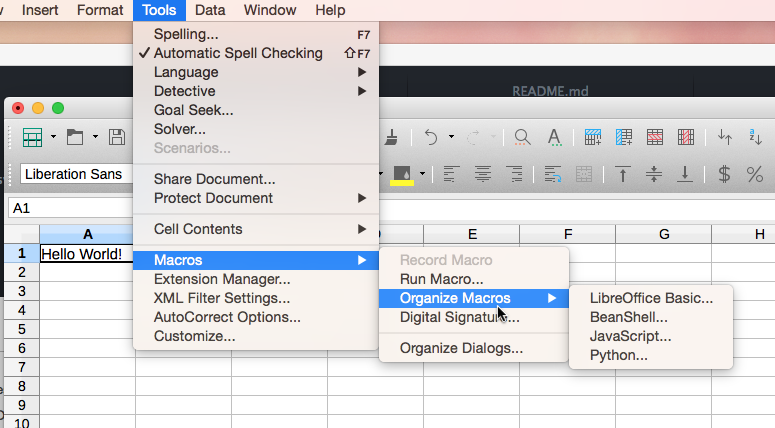
choosing Python :
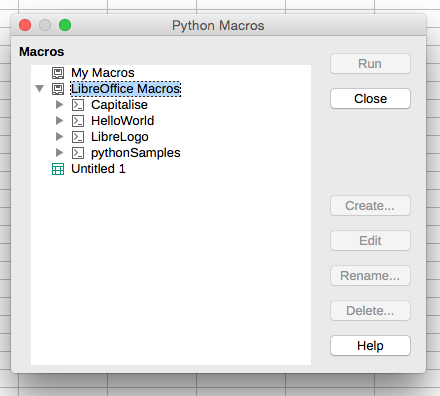
If yous become a "Coffee SE 6 Error bulletin" such equally blare
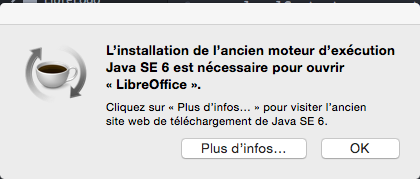
download the Java SE 6 version here.
Allow's edit a starting time macro script file myscript.py that will print the Python version, creating a method PythonVersion :
import sys def PythonVersion ( * args ): """Prints the Python version into the current document""" #get the dr. from the scripting context which is made available to all scripts desktop = XSCRIPTCONTEXT . getDesktop () model = desktop . getCurrentComponent () #cheque whether there'south already an opened document. Otherwise, create a new i if not hasattr ( model , "Text" ): model = desktop . loadComponentFromURL ( "private:manufacturing plant/swriter" , "_blank" , 0 , () ) #go the XText interface text = model . Text #create an XTextRange at the end of the document tRange = text . Terminate #and set the string tRange . Cord = "The Python version is %s.%s.%s" % sys . version_info [: 3 ] + " and the executable path is " + sys . executable return None and copy it to the Macro directory for LibreOffice :
cp myscript.py /Applications/LibreOffice.app/Contents/Resources/Scripts/python/ (under Windows it is C:\Program Files (x86)\LibreOffice five\share\Scripts\python directory).
Open up a new text certificate and run information technology from the menu :
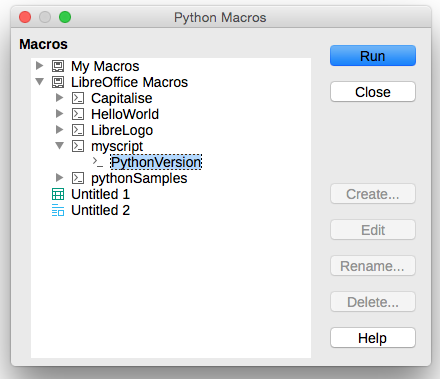
In instance at that place are multiple methods, all of them will exist exported, but nosotros can also specify which ane to export with the following statement at the end of the file :
g_exportedScripts = PythonVersion , Its spreadsheet analogue would be :
import sys def PythonVersion ( * args ): """Prints the Python version into the current document""" #get the doc from the scripting context which is made available to all scripts desktop = XSCRIPTCONTEXT . getDesktop () model = desktop . getCurrentComponent () #check whether there's already an opened document. Otherwise, create a new one if not hasattr ( model , "Sheets" ): model = desktop . loadComponentFromURL ( "private:factory/scalc" , "_blank" , 0 , () ) #get the XText interface sail = model . Sheets . getByIndex ( 0 ) #create an XTextRange at the end of the certificate tRange = sheet . getCellRangeByName ( "C4" ) #and set the string tRange . Cord = "The Python version is %due south.%s.%south" % sys . version_info [: 3 ] #do the aforementioned for the python executable path tRange = sheet . getCellRangeByName ( "C5" ) tRange . String = sys . executable return None For distribution of code, OXT format acts as containers of code that will exist installed by the Extension Manager or with the command line /Applications/LibreOffice.app/Contents/MacOS/unopkg.
A tutorial under Ubuntu
Other examples
Pack your script inside the document : the OpenDocument format
OpenDocument files are zipped directories.
You can have a await at inside by creating and saving a opendocument spreadsheet certificate with LibreOffice then unzipping information technology :
unzip Documents/examination.ods -d test You'll get the post-obit listing of files and subdirectories in your extracted file :
├── Configurations2 │ ├── accelerator │ │ └── current.xml │ ├── floater │ ├── images │ │ └── Bitmaps │ ├── menubar │ ├── popupmenu │ ├── progressbar │ ├── statusbar │ ├── toolbar │ └── toolpanel ├── META-INF │ └── manifest.xml ├── Thumbnails │ └── thumbnail.png ├── content.xml ├── manifest.rdf ├── meta.xml ├── mimetype ├── settings.xml └── styles.xml Yous can directly append your script to the file with the zipfile library. Let's create include_macro.py :
import zipfile import shutil import os import sys print ( "Delete and create directory with_macro" ) shutil . rmtree ( "with_macro" , Truthful ) os . mkdir ( "with_macro" ) filename = "with_macro/" + sys . argv [ i ] impress ( "Open file " + sys . argv [ one ]) shutil . copyfile ( sys . argv [ i ], filename ) doctor = zipfile . ZipFile ( filename , 'a' ) md . write ( "myscript.py" , "Scripts/python/myscript.py" ) manifest = [] for line in doc . open ( 'META-INF/manifest.xml' ): if '</manifest:manifest>' in line . decode ( 'utf-eight' ): for path in [ 'Scripts/' , 'Scripts/python/' , 'Scripts/python/myscript.py' ]: manifest . append ( ' <manifest:file-entry manifest:media-type="awarding/binary" manifest:full-path="%due south"/>' % path ) manifest . append ( line . decode ( 'utf-8' )) dr. . writestr ( 'META-INF/manifest.xml' , '' . join ( manifest )) medico . close () print ( "File created: " + filename ) such that to include your Python macro inside certificate.ods, just type command
python include_macro.py certificate.ods Later on enabling macros,
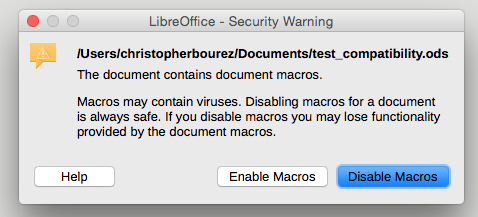
you should be able to run your macro
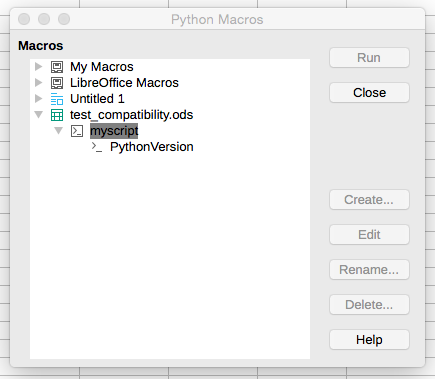
Add a button control to launch your macro
Show the form control toolbar in the card View > Toolbars > Form Controls, activate Blueprint fashion (first red arrow) and add a button (2d reddish arrow) :
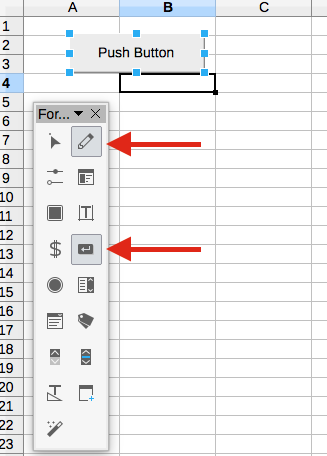
Right click on the push button to open the control properties and link with your macro :
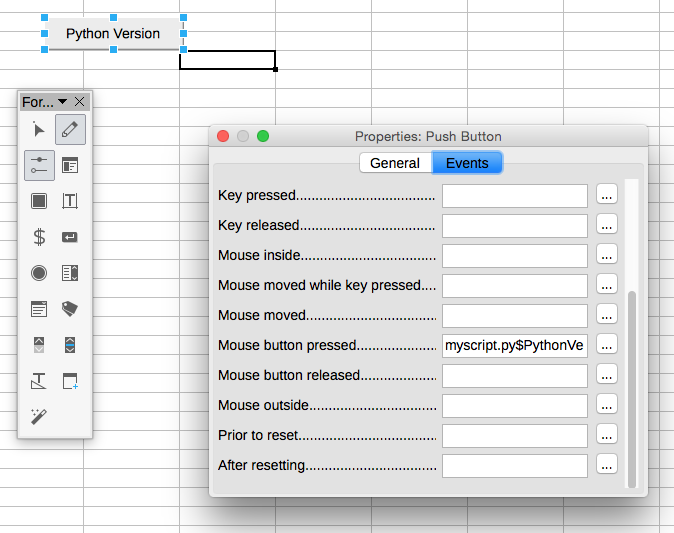
Toggle design way to OFF, close your toolbars. Your document is ready.
You tin can download my example hither. This document can be used to check everything works as espected on the LibreOffice version of your customer.
You can also add the button programmatically :
sheet = model . Sheets . getByIndex ( 0 ) LShape = model . createInstance ( "com.sunday.star.drawing.ControlShape" ) aPoint = uno . createUnoStruct ( 'com.sun.star.awt.Signal' ) aSize = uno . createUnoStruct ( 'com.sun.star.awt.Size' ) aPoint . X = 500 aPoint . Y = 1000 aSize . Width = 5000 aSize . Superlative = 1000 LShape . setPosition ( aPoint ) LShape . setSize ( aSize ) oButtonModel = smgr . createInstanceWithContext ( "com.lord's day.star.form.component.CommandButton" , ctx ) oButtonModel . Proper name = "Click" oButtonModel . Label = "Python Version" LShape . setControl ( oButtonModel ) oDrawPage = sheet . DrawPage oDrawPage . add together ( LShape ) and add a listener
aEvent = uno . createUnoStruct ( "com.sun.star.script.ScriptEventDescriptor" ) aEvent . AddListenerParam = "" aEvent . EventMethod = "actionPerformed" aEvent . ListenerType = "XActionListener" aEvent . ScriptCode = "myscript.py$PythonVersion (document, Python)" aEvent . ScriptType = "Script" oForm = oDrawPage . getForms (). getByIndex ( 0 ) oForm . getCount () oForm . registerScriptEvent ( 0 , aEvent ) or
import unohelper from com.sun.star.awt import XActionListener course MyActionListener ( unohelper . Base , XActionListener ): def __init__ ( self ): impress ( "ok1" ) def actionPerformed ( self , actionEvent ): print ( "ok2" ) doc = model . getCurrentController () doc . getControl ( oButtonModel ) doc . getControl ( oButtonModel ). addActionListener ( MyActionListener ()) Start a macro when document starts / opens / is loaded
In the toolbar Tools > Customize, add the macro :
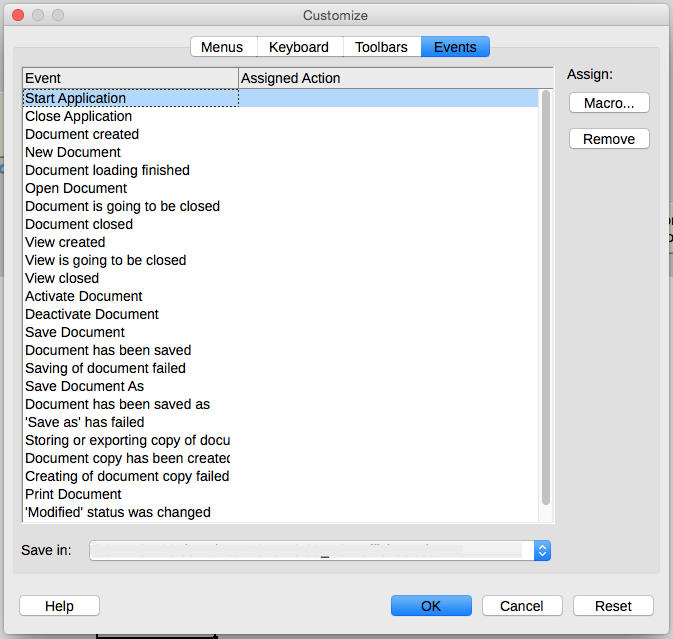
Y'all have the pick to save the preference
-
either in the certificate itself, in this case the macro will exist executed whenever the certificate is opened on whatever calculator
-
or in the LibreOffice install on your local computer, in this instance the macro will be executed for every opened document.
Add together a listener when the cell content changes
import uno , unohelper from com.dominicus.star.util import XModifyListener doc = XSCRIPTCONTEXT . getDocument () #get your sail and cell cell = .. course myChange ( XModifyListener , unohelper . Base of operations ): def __init__ ( self ,): cocky . doc = None def setDocument ( self , doc ): self . doc = physician def modified ( self , oEvent ): yourFunction () def disposing ( self , oEvent ): pass def AddMyListener : g = myChange () grand . setDocument ( doc ) jail cell . addModifyListener ( m ) g_ImplementationHelper = unohelper . ImplementationHelper () g_ImplementationHelper . addImplementation ( myChange , 'com.sun.star.util.XModifyListener' ,() ) g_exportedScripts = AddMyListener , Spreadsheet methods
Go a sheet
sheet = model.Sheets.getByName(sheet_name)
sheet = model.Sheets.getByIndex(0)
model.getCurrentController.setActiveSheet(sheet) prepare the sheet active
Protect / unprotect a canvass
canvas.protect(countersign)
sheet.unprotect(password)
sheet.isProtected()
Get a cell
sheet.getCellByPosition(col, row)
canvass.getCellRangeByName("C4")
Go cell range
sheet.getCellRangeByName("C4:x")
sheet.getCellRangeByName("C4:D10")
Go cell value
prison cell.getType() cell type (in from com.sun.star.table.CellContentType import TEXT, EMPTY, VALUE, FORMULA)
cell.getValue() or cell.Value
jail cell.getString() or prison cell.String
jail cell.getFormula() or cell.Formula
You lot can also accept a look at number formats, dates, …
Ready cell value
cell.setValue(value) or cell.Value=value
cell.setString(string) or prison cell.String=string
cell.setFormula(formula) or prison cell.Formula=formula (example : prison cell.setFormula("=A1"))
Cell background color (hexadecimal)
cell.CellBackColor=-1 (no color)
jail cell.CellBackColor=0 (black)
cell.CellBackColor=255 (blue)
prison cell.CellBackColor=0xFF0000 (red)
Become range value as an array
range.getDataArray()
Certificate Path
model.URL
import bone if os . proper noun == "nt" : directory = os . path . dirname ( unohelper . fileUrlToSystemPath ( model . URL )) else : directory = bone . path . dirname ( model . URL )[ 7 :] Named Ranges
Named ranges are like "allonym" or shortcuts defining ranges in the document :
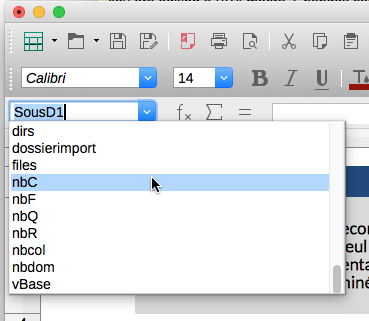
Set a named range :
oCellAddress = active_sheet . getCellRangeByName ( "C4" ). getCellAddress () model . NamedRanges . addNewByName ( "Test Proper noun" , "C4" , oCellAddress , 0 ) Get named range :
model.NamedRanges.getByName("Test Name")
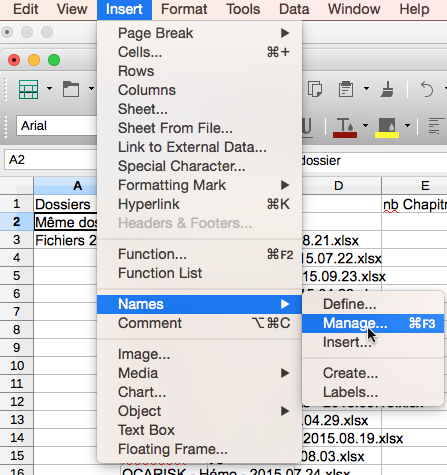
List named ranges :
model.NamedRanges.getElementNames()
Exam named range :
model.NamedRanges.hasByName("dirs")
Remove a named range :
model.NamedRanges.removeByName('dirs')
get cell cavalcade and row
jail cell.getCellAddress().Cavalcade
cell.getCellAddress().Row
get cell canvas
cell.getCellAddress().Sail
go range column and rowstart/cease start/end/count
cell/range.getRangeAddress().StartRow
cell/range.getRangeAddress().StartColumn
cell/range.getRangeAddress().EndRow
cell/range.getRangeAddress().EndColumn
range.Rows.getCount() number of rows
range.Columns.getCount() number of columns
range.getCellFormatRanges()
clear contents
range.clearContents(4) clears the cells with a String as value other clearing flags
delete rows
sheet.getRows().removeByIndex(start_row,nb_rows)
Data pilots (equivalent to Excel'due south information pivots)
canvas.getDataPilotTables()
datapilot = sail.getDataPilotTables().getByIndex(0)
datapilot.SourceRange
datapilot.SourceRange=
datapilot.DataPilotFields
sheet.DataPilotTables.getByIndex(0).refresh()
Shapes
canvass.DrawPage.getCount()
sail.DrawPage.getByIndex(0)
sheet.DrawPage.getByIndex(17).Visible=Imitation
Charts
Become the charts
oCharts = sheet.getCharts()
Change dataseries order :
oXChartType = oCharts . getByIndex ( 0 ). getEmbeddedObject (). getFirstDiagram (). getCoordinateSystems ()[ 0 ]. getChartTypes ()[ 0 ] oSeries = oXChartType . getDataSeries () oNewSeries = () oNewSeries = ( oSeries [ 4 ], oSeries [ 3 ], oSeries [ ii ], oSeries [ one ], oSeries [ 0 ] ) oXChartType . setDataSeries ( oNewSeries ) Change color and transparency :
oCharts . getByIndex ( pi ). getEmbeddedObject (). getFirstDiagram (). getCoordinateSystems ()[ 0 ]. getChartTypes ()[ 0 ]. DataSeries [ 0 ]. Colour = int ( "7030A0" , sixteen ) oCharts . getByIndex ( pi ). getEmbeddedObject (). getFirstDiagram (). getCoordinateSystems ()[ 0 ]. getChartTypes ()[ 0 ]. DataSeries [ 0 ]. Transparency = fifty Deal with enumerations
RangesEnum = active_sheet . getCellRangeByName ( "C4" ). getCellFormatRanges (). createEnumeration () while RangesEnum . hasMoreElements (): orange = RangesEnum . nextElement () Export as a CSV in UTF-8
struct3 = uno . createUnoStruct ( 'com.lord's day.star.beans.PropertyValue' ) struct3 . Name = "FilterName" struct3 . Value = "Text - txt - csv (StarCalc)" struct4 = uno . createUnoStruct ( 'com.sun.star.beans.PropertyValue' ) struct4 . Proper noun = "FilterOptions" struct4 . Value = "59,34,76,one,,0,faux,true,true,false" Current impress area
model.CurrentController.ActiveSheet.PrintAreas[0]
Save every bit PDF
import uno from com.lord's day.star.beans import PropertyValue properties = [] p = PropertyValue () p . Name = 'FilterName' p . Value = 'calc_pdf_Export' backdrop . append ( p ) model . storeToURL ( 'file:///tmp/exam.pdf' , tuple ( properties )) #less verbose : model . storeToURL ( 'file:///tmp/test2.pdf' , tuple ([ PropertyValue ( 'FilterName' , 0 , 'calc_pdf_Export' , 0 )])) Add filter data options (bachelor options), such a page range :
fdata = [] fdata1 = PropertyValue () fdata1 . Proper noun = "PageRange" fdata1 . Value = "2" fdata . append ( fdata1 ) args = [] arg1 = PropertyValue () arg1 . Proper name = "FilterName" arg1 . Value = "calc_pdf_Export" arg2 = PropertyValue () arg2 . Name = "FilterData" arg2 . Value = uno . Any ( "[]com.dominicus.star.beans.PropertyValue" , tuple ( fdata ) ) args . append ( arg1 ) args . append ( arg2 ) model . storeToURL ( 'file:///tmp/exam.pdf' , tuple ( args )) or a selection of cells "$A$1:$B$3"
fdata = [] fdata1 = PropertyValue () fdata1 . Name = "Pick" oCellRange = param_sheet . getCellRangeByName ( "$A$one:$B$3" ) fdata1 . Value = oCellRange fdata . append ( fdata1 ) args = [] arg1 = PropertyValue () arg1 . Proper name = "FilterName" arg1 . Value = "calc_pdf_Export" arg2 = PropertyValue () arg2 . Name = "FilterData" arg2 . Value = uno . Whatever ( "[]com.sun.star.beans.PropertyValue" , tuple ( fdata ) ) args . append ( arg1 ) args . append ( arg2 ) model . storeToURL ( 'file:///tmp/exam.pdf' , tuple ( args )) Determining the used area
cursor = canvas . createCursor () cursor . gotoStartOfUsedArea ( False ) cursor . gotoEndOfUsedArea ( True ) rangeaddress = cursor . getRangeAddress () Create a bulletin box
from com.sun.star.awt.MessageBoxType import MESSAGEBOX , INFOBOX , WARNINGBOX , ERRORBOX , QUERYBOX from com.lord's day.star.awt.MessageBoxButtons import BUTTONS_OK , BUTTONS_OK_CANCEL , BUTTONS_YES_NO , BUTTONS_YES_NO_CANCEL , BUTTONS_RETRY_CANCEL , BUTTONS_ABORT_IGNORE_RETRY from com.sun.star.awt.MessageBoxResults import OK , Aye , NO , Cancel parentwin = model . CurrentController . Frame . ContainerWindow box = parentwin . getToolkit (). createMessageBox ( parentwin , MESSAGEBOX , BUTTONS_OK , "Here the title" , "Here the content of the message" ) consequence = box . execute () if result == OK : print ( "OK" ) returns the value.
Have a wait here as well.
Work on selections using the dispatcher
# admission the dispatcher dispatcher = smgr . createInstanceWithContext ( "com.lord's day.star.frame.DispatchHelper" , ctx ) # access the document doc = model . getCurrentController () # enter a string struct = uno . createUnoStruct ( 'com.sunday.star.beans.PropertyValue' ) struct . Name = 'StringName' struct . Value = 'How-do-you-do World!' dispatcher . executeDispatch ( doc , ".uno:EnterString" , "" , 0 , tuple ([ struct ])) # focus / go to cell struct = uno . createUnoStruct ( 'com.sun.star.beans.PropertyValue' ) struct . Name = 'ToPoint' struct . Value = 'Sheet1.A1' dispatcher . executeDispatch ( md , ".uno:GoToCell" , "" , 0 , tuple ([ struct ])) # drag and autofill struct = uno . createUnoStruct ( 'com.sun.star.beans.PropertyValue' ) struct . Name = 'EndCell' struct . Value = 'Sheet1.A10' dispatcher . executeDispatch ( physician , ".uno:AutoFill" , "" , 0 , tuple ([ struct ])) # recalculate dispatcher . executeDispatch ( doc , ".uno:Calculate" , "" , 0 , tuple ([])) # unDo dispatcher . executeDispatch ( physician , ".uno:Undo" , "" , 0 , ()) # reDo dispatcher . executeDispatch ( doc , ".uno:Redo" , "" , 0 , ()) # quit LibreOffice dispatcher . executeDispatch ( md , ".uno:Quit" , "" , 0 , ()) # insert rows dispatcher . executeDispatch ( doctor , ".uno:InsertRows" , "" , 0 , ()) # delete rows dispatcher . executeDispatch ( md , ".uno:DeleteRows" , "" , 0 , ()) # insert columns dispatcher . executeDispatch ( doc , ".uno:InsertColumns" , "" , 0 , ()) # delete columns dispatcher . executeDispatch ( dr. , ".uno:DeleteColumns" , "" , 0 , ()) # re-create, cut, paste dispatcher . executeDispatch ( doc , ".uno:Re-create" , "" , 0 , ()) dispatcher . executeDispatch ( doctor , ".uno:Cutting" , "" , 0 , ()) dispatcher . executeDispatch ( doc , ".uno:Paste" , "" , 0 , ()) # clear contents of column A struct = uno . createUnoStruct ( 'com.sun.star.beans.PropertyValue' ) struct . Name = 'Flags' struct . Value = 'A' dispatcher . executeDispatch ( doc , ".uno:Delete" , "" , 0 , tuple ([ struct ])) # saveAs struct = uno . createUnoStruct ( 'com.lord's day.star.beans.PropertyValue' ) struct . Proper noun = 'URL' struct . Value = 'file:///Users/christopherbourez/Documents/test_save.ods' dispatcher . executeDispatch ( doc , ".uno:SaveAs" , "" , 0 , tuple ([ struct ])) # open struct = uno . createUnoStruct ( 'com.dominicus.star.beans.PropertyValue' ) struct . Name = 'URL' struct . Value = 'file:///Users/christopherbourez/Documents/examination.ods' dispatcher . executeDispatch ( doctor , ".uno:Open" , "" , 0 , tuple ([ struct ])) You tin can have a look at other actions such equally Protection, Abolish, TerminateInplaceActivation, InsertContents (with backdrop 'Flags','FormulaCommand','SkipEmptyCells','Transpose','AsLink','MoveMode' )
Have a look at the equivalent in Visual Basic.
Create a dialog
Let's create and open a dialog with a button push button and a label such equally :

(example from this thread)
# create dialog dialogModel = smgr . createInstanceWithContext ( "com.sun.star.awt.UnoControlDialogModel" , ctx ) dialogModel . PositionX = 10 dialogModel . PositionY = ten dialogModel . Width = 200 dialogModel . Top = 100 dialogModel . Title = "Runtime Dialog Demo" # create listbox listBoxModel = dialogModel . createInstance ( "com.sun.star.awt.UnoControlListBoxModel" ) listBoxModel . PositionX = x listBoxModel . PositionY = v listBoxModel . Width = 100 listBoxModel . Height = xl listBoxModel . Name = "myListBoxName" listBoxModel . StringItemList = ( 'a' , 'b' , 'c' ) # create the button model and fix the properties buttonModel = dialogModel . createInstance ( "com.sunday.star.awt.UnoControlButtonModel" ) buttonModel . PositionX = l buttonModel . PositionY = 50 buttonModel . Width = fifty buttonModel . Elevation = 14 buttonModel . Name = "myButtonName" buttonModel . Characterization = "Click Me" # create the label model and set the backdrop labelModel = dialogModel . createInstance ( "com.sun.star.awt.UnoControlFixedTextModel" ) labelModel . PositionX = x labelModel . PositionY = 70 labelModel . Width = 100 labelModel . Height = 14 labelModel . Proper noun = "myLabelName" labelModel . Label = "Clicks " # insert the control models into the dialog model dialogModel . insertByName ( "myButtonName" , buttonModel ) dialogModel . insertByName ( "myLabelName" , labelModel ) dialogModel . insertByName ( "myListBoxName" , listBoxModel ) # create the dialog control and set up the model controlContainer = smgr . createInstanceWithContext ( "com.sun.star.awt.UnoControlDialog" , ctx ) controlContainer . setModel ( dialogModel ) oBox = controlContainer . getControl ( "myListBoxName" ) oLabel = controlContainer . getControl ( "myLabelName" ) oButton = controlContainer . getControl ( "myButtonName" ) oBox . addItem ( 'd' , 4 ) # create a peer toolkit = smgr . createInstanceWithContext ( "com.sun.star.awt.ExtToolkit" , ctx ) controlContainer . setVisible ( False ) controlContainer . createPeer ( toolkit , None ) # execute it controlContainer . execute () but clicking does not execute anything. Let'south close information technology, add listeners to increase the characterization counter when clicking the button, and re-open the dialog :
import unohelper from com.sunday.star.awt import XActionListener grade MyActionListener ( unohelper . Base , XActionListener ): def __init__ ( cocky , labelControl , prefix ): cocky . nCount = 0 cocky . labelControl = labelControl cocky . prefix = prefix def actionPerformed ( self , actionEvent ): # increase click counter cocky . nCount = self . nCount + 1 self . labelControl . setText ( self . prefix + str ( cocky . nCount ) ) # add together the activeness listener oButton . addActionListener ( MyActionListener ( oLabel , labelModel . Label )) oBox . addActionListener ( MyActionListener ( oLabel , labelModel . Label )) # execute again controlContainer . execute () And permit's delete
# dispose the dialog controlContainer . dispose () Working with a class
Y'all might have created a listbox of name "Listbox"

and linked to data :
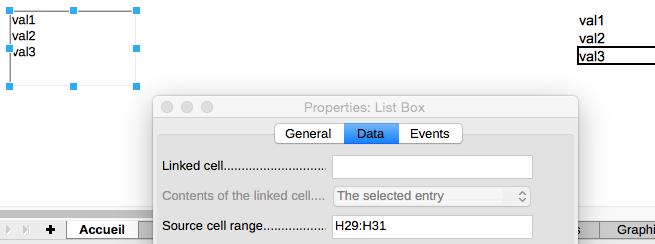
# get the canvass accueil_sheet = model . Sheets . getByName ( "Accueil" ) # access the draw page oDrawPage = accueil_sheet . DrawPage # count the number of form oDrawPage . getForms (). getCount () # get the list box of the control element ListBox = oDrawPage . getForms (). getByIndex ( 0 ). getByName ( "Listbox" ) # get the list box item list ListBox . StringItemList # go the listing box controller ListBoxCtrl = model . getCurrentController (). getControl ( ListBox ) # get the selected items: ListBoxCtrl . SelectedItems If the list box view is not in the current active sail, yous can access it with :
for i in range ( 1 , accueil_sheet . DrawPage . getCount ()): if accueil_sheet . DrawPage . getByIndex ( i ). Control . Proper noun == "ListBox" : ListBoxCtrl = accueil_sheet . DrawPage . getByIndex ( i ). Control Delight do not hesitate to do your contributions to my tutorial.
Well done !
Source: https://christopher5106.github.io/office/2015/12/06/openoffice-libreoffice-automate-your-office-tasks-with-python-macros.html
Posted by: gassowit1972.blogspot.com


0 Response to "What Can Open Openoffice.org Xml 1.0 Drawing (.sxd)?"
Post a Comment